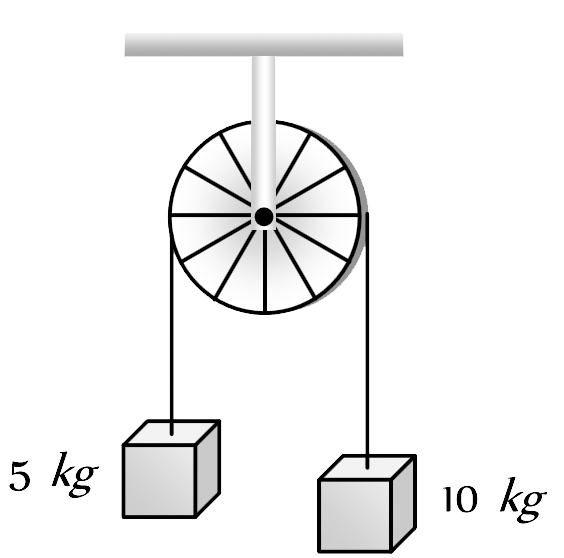A monkey of mass 40 kg climbs on a rope which can withstand a maximum tesion of 600 N In which of the following cases will the rope break ? The monkey
(a) climbs up with an acceleration of 6ms−2
(b) climbs down with an acceleration of 4ms−2
(c) climbs up with a unifrom speed of 5ms−1 (d) falls down the rope nearly freely under gravity Ignore the mass of the rope . Solution in Gujrati
(a) T−40g=240⇒T=632N
(b) 392−T=160⇒=232N
(c) T=392N
The rope will break in case (a) as Tg600N.
Topper's Solved these Questions
- BOOK - ALLEN CHAPTER - NEWTONS LAWS OF MOTIONEXERCISE - EXERCISE-I52videos
NEWTONS LAWS OF MOTION
- BOOK - ALLEN CHAPTER - NEWTONS LAWS OF MOTIONEXERCISE - EXERCISE-II112videos
NEWTONS LAWS OF MOTION
- BOOK - ALLEN CHAPTER - NEWTONS LAWS OF MOTIONEXERCISE - EXERCISE-III28videos
NEWTONS LAWS OF MOTION
- BOOK - ALLEN CHAPTER - NEWTON'S LAWS OF MOTION & FRICTIONEXERCISE - EXERCISE (JA)4videos
NEWTON'S LAWS OF MOTION & FRICTION
- BOOK - ALLEN CHAPTER - RACEEXERCISE - Basic Maths (Wave Motion & Dopplers Effect) (Stationary waves & doppler effect, beats)25videos
RACE
Similar Questions
USS 150) Two masses of 5 kg and 10 kg are connected to a pulley as shown. What will be the acceleration of the system (g= acceleration due to gravity)
 04:25View Solution
04:25View SolutionA particle is in straight line motion with uniform velocity A force is not required
07:41View SolutionAssertion: The driver in a vechicle moving with a constant speed on a straight road is in a non-inertial frame of referance.
Reason: A reference frame in which Newton's laws of motion are applicable is non-inertial.04:37View SolutionA piece of wire is bent in the shape of a parabola y=kx2 (y-axis vertical) with a bead of mass m on it. The bead can slide on the wire without friction. It stays at the lowest point of the parabola when the wire is at rest. The wire is now accelerated parallel to the x-axis with a constant acceleration a. The distance of the new equilibrium position of the bead, where the bead can stay at rest with respect to the wire, from the y-axis is:
03:35View SolutionThe frequency of a radar is 780 MHz. After getting reflected from an approaching aeroplane, the apparent frequency is more than the actual frequency by 2.6 kHz. The aeroplane has a speed of
03:56View SolutionA monkey of mass 40 kg climbs on a rope which can withstand a maximum tesion of 600 N In which of the following cases will the rope break ? The monkey (a) climbs up with an acceleration of 6 ms^(-2) (b) climbs down with an acceleration of 4 ms^(-2) (c) climbs up with a unifrom speed of 5 ms^(-1) (d) falls down the rope nearly freely under gravity Ignore the mass of the rope .
03:14View Solution40 किग्रा संहति का कोई बंदर 600 N का अधिकतम तनाव सह सकने योग्य किसी रस्सी पर चढ़ता हैं । नीचे दी गई स्थितियों में से किससे रस्सी टूट जायेगी -
(i) बन्दर 6ms−2 त्वरण से ऊपर चढ़ता हैं ।
(ii) बंदर 4ms−2 त्वरण से नीचे उतरता हैं ।
(iii) बंदर 5ms−1 की एकसमान चाल से ऊपर चढ़ता हैं ।
(iv) बंदर लगभग मुक्त रुप से गुरुत्व बल के प्रभाव में रस्सी से गिरता हैं । ( रस्सी की संहति उपेक्षणीय मानियं । )
 View Solution
View SolutionA monkey of mass 40 kg climbs a rope. Which can stand a maximum tension of 600 N. In which of the following cases will the rope break? The monkey
06:09View SolutionA monkey of mass 40 kg climbs a rope. Which can stand a maximum tension of 600 N. In which of the following cases will the rope break: The monkey
climbs up with a uniform speed of 5 m⋅s−1View SolutionA monkey of mass 40 kg climbs on a rope which can withstand a maximum tension of 600 N.In which of the following cases will the rope break? The monkey- climbs up with an acceleration of 6 m cdot s^(-2)
05:17View SolutionA monkey of mass 40 kg climbs on a rope which can withstand a maximum tension of 600 N.In which of the following cases with the rope break? The monkey-
climbs down with an acceleration of 4 m⋅s−206:53View Solution40 kg ভরসম্পন্ন একটি বাঁদর একটি দড়ি বেয়ে ওপরে ওঠার চেষ্টা করছে দড়িটি সর্বাধিক 600 N টান সহা করতে পারে। নিম্নলিখিত কোন্ ক্ষেত্রে দড়িটি ছিড়ে যাবে?
04:32View SolutionA monkey of mass 40 kg climbs on a rope. which can stand a maximum tension of 600 N. In which of the following cases will the rope break: the monkey (a) climbs up with an acceleration of 6 m s^(-2) (b) climbs down with an acceleration of 4 m s^(-2 ) (c) climbs up with a uniform speed of 5 m s^(-1) (d) falls down the rope nearly freely under gravity? (Ignore the mass of the rope).
View SolutionA monkey of mass 40 kg climbs on a rope. which can stand a maximum tension of 600 N. In which of the following cases will the rope break: the monkey (a) climbs up with an acceleration of 6ms−2 (b) climbs down with an acceleration of 4ms−2 (c) climbs up with a uniform speed of 5ms−1 (d) falls down the rope nearly freely under gravity? (Ignore the mass of the rope).
 02:31View Solution
02:31View SolutionA monkey of mass 40 kg climbs on a rope. which can stand a maximum tension of 600 N. In which of the following cases will the rope break: the monkey (a) climbs up with an acceleration of 6ms−2 (b) climbs down with an acceleration of 4ms−2 (c) climbs up with a uniform speed of 5ms−1 (d) falls down the rope nearly freely under gravity? (Ignore the mass of the rope).
 02:16View Solution
02:16View SolutionA monkey of mass 40 kg climbs on a rope which can withstand a maximum tension of 600 N In which of the following cases will the rope break : The monkey
(a) climbs up with an acceleration of 6ms−2
(b) climbs down with an acceleration of 4ms−2
(c) climbs up with a uniform speed of 5ms−1
(d) falls down the rope nearly freely under gravity ? (Ignore the mass of the rope.)View Solution

